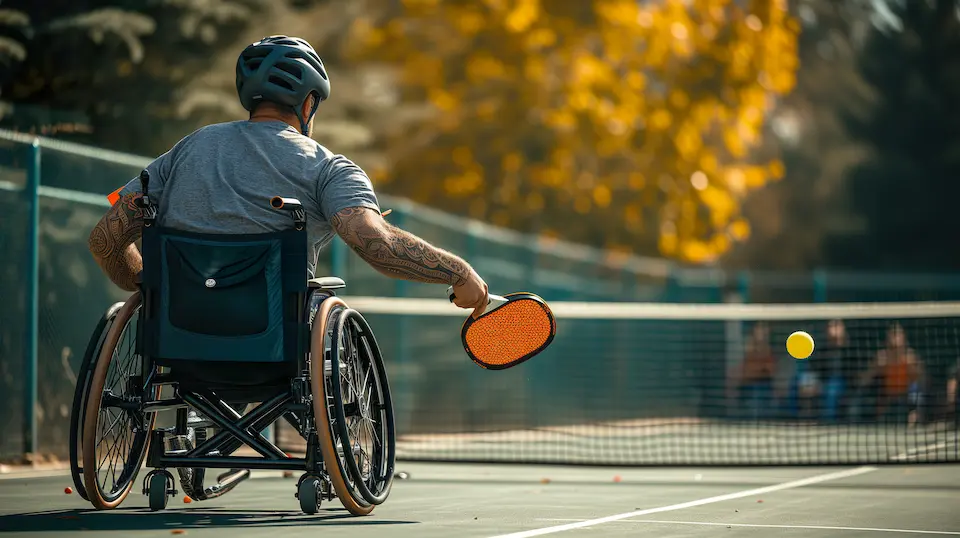Wheelchair pickleball is an adaptive form of pickleball where one or more players are in a wheelchair. To accommodate this type of play, special considerations for the court design need to be made. If you are playing pickleball in a wheelchair or plan to construct a pickleball court for wheelchair-bound players, you should be aware of what the court should have to make it safe and fair for mixed-ability play.

At North State Resurfacing, we believe everyone should have the chance to play America’s fastest-growing sport and any other sport they wish. We’re going to share the considerations for designing a wheelchair pickleball court as well as what rules apply for the game so that it’s game on for everyone!
Wheelchair Pickleball Court Considerations
Court Size
All pickleball courts measure 44 feet long by 20 feet wide. To play wheelchair pickleball, it’s recommended that the surface area for wheelchair pickleball is 44 feet wide and 74 feet long. The additional space is to accommodate people in a wheelchair and allow them to move around without getting hurt. While a pickleball court can still be standard size, it may be difficult or uncomfortable for wheelchair athletes to play well.
Signage & Markings
You want to have visible markers that indicate the wheelchair-accessible routes to the court. You also want to have signs that indicate the location of handicapped-accessible parking spaces and entrances to the court. Be sure that there are accessible parking spaces near the path that comes from the parking lot to the court.
Surface Concerns
The playing surface should be level and free of any debris or material that makes it difficult to move about safely. Eliminate any apparent tripping hazards and make sure that the surface is smooth and even.
The surface you choose should be slip-resistant and stable. Install ramps or sloped entrances so that wheelchair players can easily access the court. You want to be sure the dimensions and slopes of the ramps follow ADA guidelines.
Incorporating wheelchair-accessible features is essential. Install ramps or sloped entrances to allow players using wheelchairs to easily access the court. Ensure that the dimensions and slopes of the ramps comply with ADA guidelines. It is also important to provide ample space for players in wheelchairs to maneuver around the court, so they can fully participate in the game.
Accessibility Concerns
Besides making sure the court is accessible, you want to have a wheelchair-friendly layout. This means ensuring that the pathways leading to the court are wide enough to accommodate a wheelchair. By creating safe pathways, you are ensuring that the area is safe and accessible for all pickleball players.
The net should be easily adjustable to accommodate players in a wheelchair and those of different heights and abilities. This will allow everyone to have a great game regardless of any physical limitations they may have.
USAPA Wheelchair Pickleball Rules
Besides court considerations, you should also be aware of the adaptive/wheelchair pickleball rules that exist. These are the rules as stated by USA Pickleball, the national governing body for the sport of pickleball.
- The wheelchair is considered part of the player’s body. Any pickleball rules for players’ bodies apply to a player in a wheelchair, besides the non-volley zone rules, such as a ball hitting a player’s chair. This would result in a fault.
- A pickleball player in a wheelchair can hit the pickleball off a double bounce. For standing players, double bounces are considered faults.
- When a pickleball court doesn’t have 5 feet of clearance on the sides of the court, or 8 feet behind the baseline, a replay can be called if a player can’t return the ball because there isn’t enough space.
- If a standing player is playing against or with a wheelchair player, the rules for standing players apply to the standup partners, and wheelchair rules will apply to wheelchair players.
- Non-volley zone faults are based on the wheelchair’s back wheels. The front wheels of the chair may be inside the non-volley zone when volleying, but the back wheels have to be in the non-volley zone when volleying.
- Play is restricted to half of the pickleball court for players in a wheelchair who are playing singles and have a skill level of 3.5 or less. For single pickleball players with a 4.0 rating and above, the entire pickleball court is used.
- The rear wheels of a player’s wheelchair must be in the correct serving area at the point of contact on the serve in the game of pickleball.
- The front wheels may be on the baseline or the court, but the rear wheels must have contact with the proper serving area.
Following these wheelchair pickleball rules will help to ensure that everyone can fairly play pickleball whether they are wheelchair pickleball player or standing players on the court.
Are You Looking to Build a Wheelchair Pickleball Court?
The team at North State Resurfacing can construct a pickleball court that allows people of all abilities to fairly play pickleball. We will make sure that there is adequate space for players in wheelchairs to move about and enjoy playing America’s fastest-growing sport. When you work with us, you can have peace of mind that your court will follow all guidelines for wheelchair players.
Call us today at (919) 365-7500 to learn more about constructing an adaptive pickleball court with North State Resurfacing.
